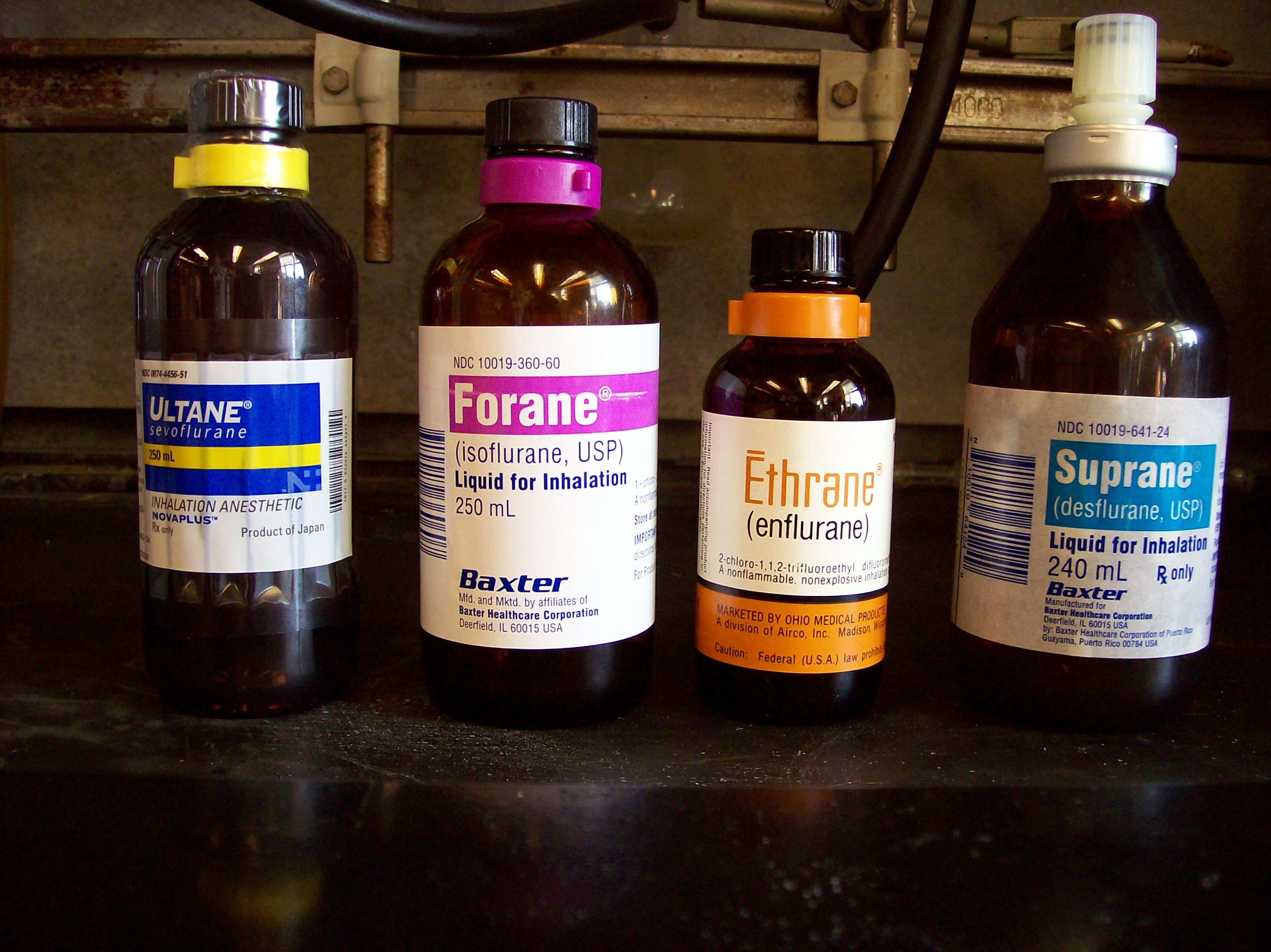|
Anaesthetics
An anesthetic (American English) or anaesthetic (British English; see spelling differences) is a drug used to induce anesthesia — in other words, to result in a temporary loss of sensation or awareness. They may be divided into two broad classes: general anesthetics, which result in a reversible loss of consciousness, and local anesthetics, which cause a reversible loss of sensation for a limited region of the body without necessarily affecting consciousness. A wide variety of drugs are used in modern anesthetic practice. Many are rarely used outside anesthesiology, but others are used commonly in various fields of healthcare. Combinations of anesthetics are sometimes used for their synergistic and additive therapeutic effects. Adverse effects, however, may also be increased. Anesthetics are distinct from analgesics, which block only sensation of painful stimuli. Analgesics are typically used in conjunction with anesthetics to control pre-, intra-, and postoperat ... [...More Info...] [...Related Items...] OR: [Wikipedia] [Google] [Baidu] |
General Anesthetic
General anaesthetics (or anesthetics) are often defined as compounds that induce a loss of consciousness in humans or loss of righting reflex in animals. Clinical definitions are also extended to include an induced coma that causes lack of awareness to painful stimuli, sufficient to facilitate surgical applications in clinical and veterinary practice. General anaesthetics do not act as analgesics and should also not be confused with sedatives. General anaesthetics are a structurally diverse group of compounds whose mechanisms encompass multiple biological targets involved in the control of neuronal pathways. The precise workings are the subject of some debate and ongoing research. General anesthetics elicit a state of general anesthesia. It remains somewhat controversial regarding how this state should be defined. General anesthetics, however, typically elicit several key reversible effects: immobility, analgesia, amnesia, unconsciousness, and reduced autonomic responsiveness to ... [...More Info...] [...Related Items...] OR: [Wikipedia] [Google] [Baidu] |
Lidocaine
Lidocaine, also known as lignocaine and sold under the brand name Xylocaine among others, is a local anesthetic of the amino amide type. It is also used to treat ventricular tachycardia and ventricular fibrillation. When used for local anaesthesia or in nerve blocks, lidocaine typically begins working within several minutes and lasts for half an hour to three hours. Lidocaine mixtures may also be applied directly to the skin or mucous membranes to numb the area. It is often used mixed with a small amount of adrenaline (epinephrine) to prolong its local effects and to decrease bleeding. If injected intravenously, it may cause cerebral effects such as confusion, changes in vision, numbness, tingling, and vomiting. It can cause low blood pressure and an irregular heart rate. There are concerns that injecting it into a joint can cause problems with the cartilage. It appears to be generally safe for use in pregnancy. A lower dose may be required in those with liver problems. I ... [...More Info...] [...Related Items...] OR: [Wikipedia] [Google] [Baidu] |
Anesthesiology
Anesthesiology, anaesthesiology or anaesthesia is the medical specialty concerned with the total perioperative medicine, perioperative care of patients before, during and after surgery. It encompasses anesthesia, intensive care medicine, critical emergency medicine, and pain medicine. A physician specialized in anesthesiology is called an anesthesiologist, anaesthesiologist, or anaesthetist, #Terminology, depending on the country. In some countries, the terms are synonymous, while in other countries, they refer to different positions and ''anesthetist'' is only used for non-physicians, such as nurse anesthetists. The core element of the specialty is the prevention and mitigation of pain and distress using various anesthetic agents, as well as the monitoring and maintenance of a patient's vital functions throughout the perioperative period. Since the 19th century, anesthesiology has developed from an experimental area with non-specialist practitioners using novel, untested drugs a ... [...More Info...] [...Related Items...] OR: [Wikipedia] [Google] [Baidu] |
Levobupivacaine
Levobupivacaine (International nonproprietary name, rINN) is a Local anesthetic, local anaesthetic drug indicated for minor and major General anaesthesia, surgical anaesthesia and pain management. It is a long-acting amide-type local anaesthetic that blocks nerve impulses by inhibiting sodium ion influx into the Neuron, nerve cells. Levobupivacaine is the S-enantiomer of racemic bupivacaine and therefore similar in pharmacological effects. The drug typically starts taking effect within 15 minutes and can last up to 16 hours depending on factors such as site of administration and dosage. Levobupivacaine was designed, in the late 1970s, to be a safer and more effective alternative to bupivacaine, which had been associated with a higher risk of cardiotoxicity. Compared to bupivacaine, levobupivacaine is associated with less vasodilation and has a longer duration of action. It is approximately 13 per cent less potent (by molarity) than racemic bupivacaine and has a longer Neuromuscula ... [...More Info...] [...Related Items...] OR: [Wikipedia] [Google] [Baidu] |
Tetracaine
Tetracaine, also known as amethocaine, is an ester local anesthetic used to numb the eyes, nose, or throat. It may also be applied to the skin before starting intravenous therapy to decrease pain from the procedure. Typically it is applied as a liquid to the area. Onset of effects when used in the eyes is within 30 seconds and last for less than 15 minutes. Common side effects include a brief period of burning at the site of use. Allergic reactions may uncommonly occur. Long-term use is generally not recommended as it may slow healing of the eye. It is unclear if use during pregnancy is safe for the baby. Tetracaine is in the ester-type local anesthetic family of medications. It works by blocking the sending of nerve impulses. Tetracaine was patented in 1930 and came into medical use in 1941. It is on the World Health Organization's List of Essential Medicines Medical uses A systematic review investigated tetracaine for use in emergency departments, especially for starting ... [...More Info...] [...Related Items...] OR: [Wikipedia] [Google] [Baidu] |
Anesthesia
Anesthesia (American English) or anaesthesia (British English) is a state of controlled, temporary loss of sensation or awareness that is induced for medical or veterinary purposes. It may include some or all of analgesia (relief from or prevention of pain), paralysis (muscle relaxation), amnesia (loss of memory), and unconsciousness. An individual under the effects of anesthetic drugs is referred to as being anesthetized. Anesthesia enables the painless performance of procedures that would otherwise require physical restraint in a non-anesthetized individual, or would otherwise be technically unfeasible. Three broad categories of anesthesia exist: * ''General anesthesia'' suppresses central nervous system activity and results in unconsciousness and total lack of Sensation (psychology), sensation, using either injected or inhaled drugs. * ''Sedation'' suppresses the central nervous system to a lesser degree, inhibiting both anxiolysis, anxiety and creation of long-term memory, ... [...More Info...] [...Related Items...] OR: [Wikipedia] [Google] [Baidu] |
Amethocaine
Tetracaine, also known as amethocaine, is an ester local anesthetic used to numb the eyes, nose, or throat. It may also be applied to the skin before starting intravenous therapy to decrease pain from the procedure. Typically it is applied as a liquid to the area. Onset of effects when used in the eyes is within 30 seconds and last for less than 15 minutes. Common side effects include a brief period of burning at the site of use. Allergic reactions may uncommonly occur. Long-term use is generally not recommended as it may slow healing of the eye. It is unclear if use during pregnancy is safe for the baby. Tetracaine is in the ester-type local anesthetic family of medications. It works by blocking the sending of nerve impulses. Tetracaine was patented in 1930 and came into medical use in 1941. It is on the World Health Organization's List of Essential Medicines Medical uses A systematic review investigated tetracaine for use in emergency departments, especially for starting i ... [...More Info...] [...Related Items...] OR: [Wikipedia] [Google] [Baidu] |
Bupivacaine
Bupivacaine, marketed under the brand name Marcaine among others, is a medication used to decrease sensation in a specific small area. In nerve blocks, it is injected around a nerve that supplies the area, or into the spinal canal's epidural space. It is available mixed with a small amount of epinephrine to increase the duration of its action. It typically begins working within 15 minutes and lasts for 2 to 8 hours. Possible side effects include sleepiness, muscle twitching, ringing in the ears, changes in vision, low blood pressure, and an irregular heart rate. Concerns exist that injecting it into a joint can cause problems with the cartilage. Concentrated bupivacaine is not recommended for epidural freezing. Epidural freezing may also increase the length of labor. It is a local anaesthetic of the amide group. Bupivacaine was discovered in 1957. It is on the World Health Organization's List of Essential Medicines. Bupivacaine is available as a generic medication. An ... [...More Info...] [...Related Items...] OR: [Wikipedia] [Google] [Baidu] |
Cinchocaine
Cinchocaine ( INN/ BAN) or dibucaine ( USAN) is an amide local anesthetic. Among the most potent and toxic of the long-acting local anesthetics, current use of cinchocaine is generally restricted to spinal and topical anesthesia. It is sold under the brand names Cincain, Nupercainal, Nupercaine and Sovcaine. Medical use Cinchocaine is the active ingredient in some topical hemorrhoid creams such as Proctosedyl. It is also a component of the veterinary drug Somulose, used for euthanasia of horses and cattle. Physical properties Cinchocaine is relatively insoluble in alkaline In chemistry, an alkali (; from the Arabic word , ) is a basic salt of an alkali metal or an alkaline earth metal. An alkali can also be defined as a base that dissolves in water. A solution of a soluble base has a pH greater than 7.0. The ... aqueous solutions. See also * Dibucaine number References Further reading * * * * Local anesthetics Quinolines Phenol ethers Carbox ... [...More Info...] [...Related Items...] OR: [Wikipedia] [Google] [Baidu] |
Erythroxylum Novogranatense Var
''Erythroxylum'' is a genus of tropical flowering plants in the family Erythroxylaceae. Many of the approximately 200 species contain the tropane alkaloid cocaine,Bieri S, Brachet A, Veuthey J, Christen P. Cocaine distribution in wild Erythroxylum species. ''Journal of ethnopharmacology''. 2006; 103: 439-447. and two of the species within this genus, ''Erythroxylum coca'' and ''Erythroxylum novogranatense'', both native to South America, are the main commercial source of cocaine and of the mild stimulant coca tea. Another species, '' Erythroxylum vaccinifolium'' (also known as catuaba) is used as an aphrodisiac in Brazilian drinks and herbal medicine. '' Erythroxylum australe'' was traditionally used by Australian Aborigines for rites and other practices. ''Erythroxylum'' species are food sources for the larvae of some butterflies and moths, including several ''Morpho'' species and '' Dalcera abrasa'', which has been recorded on ''E. deciduum'', and the species of ''Agrias''. ... [...More Info...] [...Related Items...] OR: [Wikipedia] [Google] [Baidu] |
British Approved Name
A British Approved Name (BAN) is the official, non-proprietary, or generic name given to a pharmaceutical substance, as defined in the British Pharmacopoeia (BP). The BAN is also the official name used in some countries around the world, because starting in 1953, proposed new names were evaluated by a panel of experts from WHO in conjunction with the BP commission to ensure naming consistency worldwide (an effort leading to the International Nonproprietary Name system). There is also a British Approved Name (Modified) (BANM). Combination preparations BANs are unique in that names are assigned for combination preparations as well as single-drug preparations. For example, the BAN co-amoxiclav is assigned to preparations containing amoxicillin and clavulanic acid. Most other pharmacopoeias simply refer to combination products by both ingredients in the preparation, in this example "amoxicillin with clavulanic acid". The prefix of "co-" is used for many combination drugs, inclu ... [...More Info...] [...Related Items...] OR: [Wikipedia] [Google] [Baidu] |




